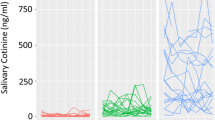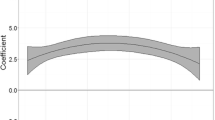Abstract
One hundred and sixteen female adolescent smokers were asked about withdrawal symptoms experienced during past attempts to give up smoking for good. Sixty-three percent reported difficulties during abstinence of the kind experienced by adult smokers. Daily smokers were more likely to report withdrawal effects than non-daily smokers (74% versus 47%, P<0.005). Reported experience of withdrawal symptoms was positively related to self-reports of cigarette consumption and depth of inhalation and nicotine intake as indexed by salivary cotinine concentrations. Reported occurrence of at least one withdrawal effect correlated positively with nicotine intake after controlling for behavioural variables. Our results indicate that teenage smokers are likely to suffer withdrawal symptoms when they try to give up. Behavioural factors and expectations based on observations of adults may have played a part in their experience of withdrawal, but it is also likely that pharmacological factors are implicated even at this early stage.
Similar content being viewed by others
References
Benowitz NL, Kuyt F, Jacob III P, Jones RT, Osman A-L (1983) Cotinine disposition and effects. Clin Pharmacol Ther 34(5):604–611
Feyerabend C, Russell MAH (1980) Rapid gas-liquid chromatographic determination of cotinine in biological fluids. Analyst 105:998–1001
Gilbert RM, Pope MA (1982) Early effects of quitting smoking. Psychopharmacology 285:537–540
Jarvis MJ, Russell MAH, Feyerabend C, Eiser JR, Morgan M, Gammage P, Gray EM (1985) Passive smoke exposure: salivary cotinine levels in a representative population sample of nonsmoking schoolchildren. Br Med J 291:927–929
McNeill AD, West RJ, Jarvis MJ, Russell MAH (1986) Do older children take in more smoke from their cigarettes? Evidence from CO levels. J Behav Med (in press)
Myrsten AL, Algerot A, Edgren B (1977) Effects of abstinence from tobacco smoking on physiological and psychological arousal levels in habitual smokers. Psychosom Med 39:25–38
Shiffman SM (1979) The tobacco withdrawal syndrome. In: Krasnegor NA (ed) Cigarette smoking as a dependence process. NIDA Research Monograph, 23, pp 158–184
Stepney R (1982) Are smokers' self-reports of inhalation a useful measure of smoke exposure? J Epidemiol Commun Health 36:109–112
Svickis DS, Hatsukami D, Hughes J, Carroll K, Pickens R (1986) Sex differences in the tobacco withdrawal syndrome. Addict Behav (in press)
West RJ, Jarvis MJ, Russell MAH, Carruthers ME, Feyerabend C (1984) Effects of nicotine replacement on the cigarette withdrawal syndrome. Br J Addict 79:215–219
West RJ, Russell MAH (1985) Pre-abstinence smoke intake and smoking motivation as predictors of severity of cigarette withdrawal symptoms. Psychopharmacology 87:334–336
Author information
Authors and Affiliations
Rights and permissions
About this article
Cite this article
McNeill, A.D., West, R.J., Jarvis, M. et al. Cigarette withdrawal symptoms in adolescent smokers. Psychopharmacology 90, 533–536 (1986). https://doi.org/10.1007/BF00174074
Received:
Revised:
Issue Date:
DOI: https://doi.org/10.1007/BF00174074




